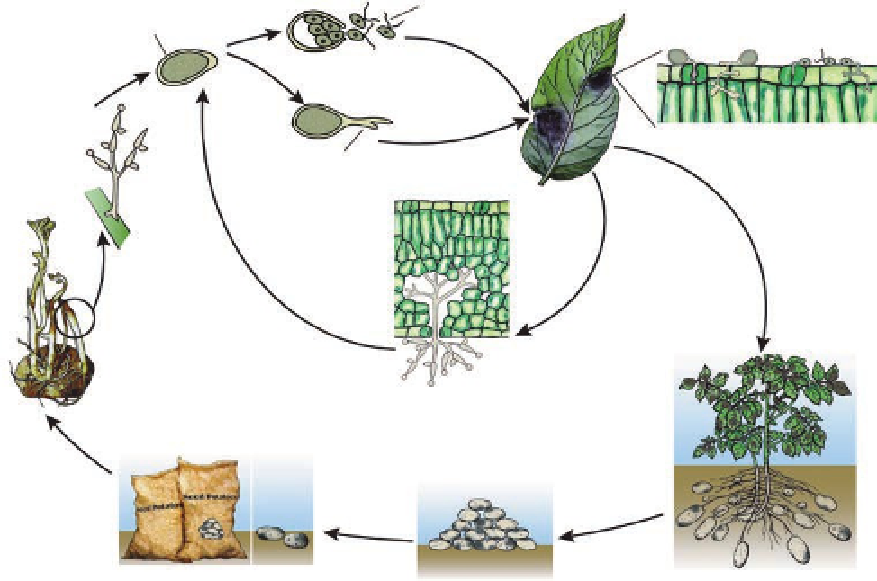Agriculture Reference
In-Depth Information
is described schematically in
Fig. 11.2
. The rela-
tionship between foliar late blight severity and
tuber blight severity has been investigated in
several studies (Hirst and Stedman, 1962; Lacey,
1965; Boyd, 1972), all of which were most likely
done using the US-
1
genotype of
P. infestans
. In
spite of the frequent strong correlation between
foliar blight severity and tuber blight, some of
these studies demonstrated cases of high inci-
dence of tuber blight in the absence of foliar
symptoms, and in contrast, Hirst
et al
. (1965)
demonstrated low incidence of tuber blight after
severe foliar blight epidemics. Potato late blight
in tubers is therefore of significant importance
in commercial production. Stored and freshly
harvested table-stock (ware) and processing
crops are directly impacted. Seed tubers may ini-
tiate epidemics by transmission from harboring
P. infestans
infected tubers to sprouts, stems, and
foliage, and may also directly reduce plant stand
and delay plant emergence, resulting in further
problems that affect yield and tuber size distri-
bution (Bussan
et al
., 2007). The dynamics of
potato blight development in tubers is influenced
largely by temperature (Kirk
et al
., 2001) and
can result in the non-emergence of plants due to
seed and sprout rot (Lambert and Currier, 1997;
Kirk
et al
., 2009; Johnson, 2010). Transmis-
sion studies need to continue because new
genotypes are now predominant and there is a
gap in our understanding of these more aggres-
sive genotypes (Haas
et al
., 2009; Moller
et al
.,
2009; Vargas
et al
., 2009; Young
et al
., 2009;
Runno- Paurson
et al
., 2010; Hu
et al
., 2012;
Rojas
et al
., 2014).
Fusarium dry rot of potato (
Solanum tubero-
sum
L
.
) is a devastating postharvest disease
worldwide and is caused by several species of
Fusarium
(Boyd, 1972; Secor and Salas, 2001).
Dry rot affects both tubers in storage and seed
tuber pieces in the field (Choiseul
et al
., 2001;
Wharton
et al
., 2007b). Losses associated with
dry rot have been estimated to range from
6
to
25%, and occasional losses as great as 60% have
been reported during long-term storage (Seppa-
nen, 1981; Estrada
et al
., 2010).
Zoospores are produced
and released from
sporangia.
SPRING
SUMMER
Sporangium
Zoospores and
sporangia infect
leaves.
Sporangiophores
are produced on
infected
seedlings.
Zoospores and sporangia
penetrate leaf surface
either through stomata or
directly through
epidermal cell wall.
Germ
tube
Secondary
sporulation and
infection of
leaves.
Zoospores and
sporangia wash off
leaves and into soil,
infecting tubers prior
to harvest.
Mycelium
from tuber
infects
seedling.
FALL
Potato late blight disease cycle
Cull pile
EARLY
SPRING
Infected seed and volunteer
potatoes.
Pathogen overwinters in cull
potato piles and volunteer
potatoes missed after harvest.
WINTER
Fig. 11.2.
The disease cycle of
Phytophthora
infestans
, causal agent of late blight.

